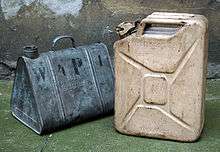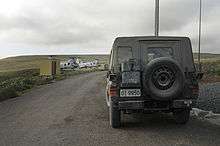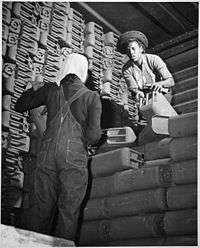Jerrycan

A jerrycan (also written as jerry can or jerrican) is a robust fuel container made from pressed steel. It was designed in Germany in the 1930s for military use to hold 20 litres (4.4 imp gal; 5.3 US gal) of fuel. The development of the jerrycan was a significant improvement on earlier designs, which required tools and funnels to use. Today similar designs are used for fuel and water containers, some of which are also produced in plastic. The designs usually emulate the original steel design and are still known as jerrycans.
Uses

Uses for the cans have expanded beyond the original intended use of carrying fuel. Today, a can's use is denoted by its colouring, and occasionally, imprinted labelling on the container itself. This is to prevent contamination of the can's contents by mixing different fuels or mixing fuel with water.
An interesting use of jerrycan is seen in folk music of Chitral, a remote area in the KPK region of Pakistan, where it has a central role as a drum. As the jerrycan is no longer manufactured from pressed steel (which had unique acoustics) this historical part of "Khowar" music is slowly being eliminated from Chitral's culture.
The US version of the jerrycan is covered by military specification MIL-C-1283[1] and has been produced since the early 1940s by a number of US manufacturers, according to a current manufacturer, Blitz.[2] The National Stock Number is 7240-00-222-3088. It is considered obsolete by a new A-A-59592A specification, having been replaced with plastic versions.
History

The history of the jerrycan is notable because the German design was reverse engineered and subsequently copied, with minor modifications, by the Allies during the Second World War. The name of the jerrycan refers to its German origins, Jerry being wartime slang for Germans.[3]
German invention
The Wehrmacht-Einheitskanister, as it was known in Germany, was first developed in 1937 by the Müller engineering firm in Schwelm to a design by their chief engineer Vinzenz Grünvogel.[4] A similar design was used in 1936 during the Spanish Civil War,[5] where they had a company logo for Ambi-Budd Presswerk G.m.b.H.
By 1939 the German military had thousands of such cans stockpiled in anticipation of war. Motorised troops were issued the cans with lengths of rubber hose in order to siphon fuel from any available source, as a way to aid their rapid advance through Poland at the start of the Second World War.[6]
American adaptation

In 1939, American engineer Paul Pleiss had built a vehicle to journey to India with his German colleague. After building the car, they realised they did not have any storage for emergency water. The German engineer had access to the stockpile of jerrycans at Berlin Tempelhof Airport and managed to take three of them. They drove across 11 national borders without incident until Field Marshal Göring sent a plane to take the engineer home. The German engineer also gave Pleiss complete specifications for the manufacture of the can.[6] Pleiss continued on to Calcutta, put his car in storage, and flew back to Philadelphia, where he told American military officials about the can. He could raise no interest.[6] Without a sample, he realised he could not get anywhere. He eventually shipped the car to New York by a roundabout method, and sent a can to Washington. The War Department decided instead to use World War I ten-US-gallon (38 l; 8.3 imp gal) cans with two screw closures, which required both a spanner and funnel for pouring.[6]
The one jerrycan in American possession was sent to Camp Holabird, Maryland, where it was redesigned. The new design retained the handles, size and shape. The US can could be stacked interchangeably with German or British cans. The weld was replaced with rolled seams which were prone to leakage. For fuel cans, the lining was removed and a wrench and funnel were required.[6] A similar water can was also adopted, with a flip-top lid and enamel lining.
The US designed jerrycan was widely used by US Army and Marine Corps units. In all overseas theaters, fuel and other petroleum products represented about 50% of all supply needs, measured by weight.[7] In the European Theatre of Operations alone, over 19,000,000 were required to support US forces by May 1945.[7]
The jerrycan played an important role in ensuring fuel supply to Allied operations. A single standard US 2.5 ton truck could carry 875 gallons of fuel loaded in jerrycans. [7] US logisticians requested over 1,300,000 per month to replace losses; these cans were provided by US and British manufacturers, but supply could not keep up with demand.[7] Loss of jerrycans in units was severe, with 3,500,000 reported 'lost' in October 1944, for example.[7] At one point in August, 1944, lack of cans (caused by losses) actually limited the supply of fuel that could be brought forward to combat units, even though the fuel was available in rear areas. [7]
The US design was slightly lighter than the German can (10 pounds vs. 11.5 for the German version). [7] These fuel containers were subsequently used in all theatres of war around the world.[6] Such was the importance of the cans in the war effort that President Roosevelt noted "Without these cans it would have been impossible for our armies to cut their way across France at a lightning pace which exceeded the German Blitzkrieg of 1940."[4]
British necessity
At the beginning of the Second World War, the British Army were equipped with simple rectangular fuel containers: a 2-imperial-gallon (9.1 l; 2.4 US gal) container made of pressed steel and a 4-imperial-gallon (18 l; 4.8 US gal) container made from tin plate. While the 2 gallon containers were relatively strong, they were expensive to produce. The 4 gallon containers, which were mainly manufactured in Egypt, were cheap and plentiful but they were not very robust. Consequently, they were colloquially known as flimsies. The first 4-gallon containers were protected by a wooden case, packed in pairs of tins to a case, and were reasonably robust. As the war progressed, this case was replaced by thin plywood or cardboard and gave little protection.[8] These flimsies were considered as only usable for one trip and were usually discarded at their destination, rather than returned for re-use. One informal military use was as the 'Benghazi burner' cooking stove.
While adequate for transport by road in Europe, the flimsies proved to be extremely unsatisfactory during the North African Campaign and severely hampered the operation of the British Eighth Army.[8] The transport of fuel over rough terrain often resulted in much of the fuel (as much as 25 percent) being lost as the containers were easily punctured.[8] Leakages also made vehicles liable to catch fire. Cargo ships loaded with fuel in flimsies were also dangerous, with leaking fuel accumulating in cargo holds. At least one such ship exploded. [7]
When the British Army first saw the German fuel cans during the invasion of Norway in 1940, the British immediately saw the advantages of the superior design. The containers had three handles on them which allowed easy handling by one or two people, or movement bucket brigade-style. The handle design also allows for two empty cans to be carried in each hand.
The sides of the can were marked with cross-like indentations that strengthened the can while allowing the contents to expand, as did an air pocket under the handles when the can was filled correctly. Rather than a screw cap, the containers used a cam lever release mechanism with a short spout secured with a snap closure and an air-pipe to the air pocket which enabled smooth pouring (which was omitted in some copies). The interior was also lined with an impervious plastic, first developed for steel beer barrels that would allow the can to be used for either water or gasoline. The can was welded and had a gasket for a leak-proof mouth. The British used cans captured from the "Jerries" (Germans) — hence "jerrycans" — in preference to their own containers as much as possible. Later in 1940, Pleiss was in London and British officers asked him about the design and manufacture of the jerrycan. Pleiss ordered the second of his three jerrycans flown to London.[6] After the second capture of Benghazi at the end of 1941, large numbers of Axis jerrycans were captured, sufficient to equip some units such as the Long Range Desert Group.[8]
Russian usage
The strength of the Wehrmachtskanister was determined in the Soviet Union. Its design was later copied and the Soviet Army accepted it as the standard container for liquids. This container is still being produced and used in modern Russia. In civilian use this container is used primarily for automotive fuel and lubricants.[9]
Modern usage
The German/British design jerrycan is still a standard fuel and other liquids container in the armies of the NATO countries.
Finnish designer Eero Rislakki designed a plastic jerrycan in 1970 with a small screwable stopper on the top side behind the handle to allow air flowing in to ensure smooth fuel outflow. It is lighter than the original design yet almost as sturdy. It was quickly adopted by the Finnish armed forces, and is commercially available.
Regulations
Current US regulations
As of January 10, 2009 all portable fuel containers are required to conform to two new regulations:[10]
- They must meet new federal Mobile Source Air Toxic regulations, based on the California Air Resources Board’s regulations.[11]
- They must meet the requirements of the Children’s Gasoline Burn Prevention Act.[12]
These new regulations do not apply to OSHA-approved metal safety containers, but rather to the common red plastic, portable gas cans. The regulations apply only to newly manufactured gasoline cans, and there is no requirement on the part of users to discard their existing cans or to upgrade, although the EPA provides informational resources for implementing community Gas Can Exchange Programs.[13]
Furthermore, in the state of California, the following colours are mandated:[14]
- red for gasoline
- yellow for diesel
- blue for kerosene
Per ASTM F852, the particular shades should be "medium yellow" and "medium blue".[15]
Current European regulations
The transportation of dangerous goods (which includes liquid fuels) within Europe is governed by the European Agreement concerning the International Carriage of Dangerous Goods by Road (ADR).[16] A jerrycan is defined within Chapter 1.2 of the 2011 ADR as "a metal or plastics packaging of rectangular or polygonal cross-section with one or more orifices", a definition which includes the traditional jerrycan but which also covers a wide range of other packagings.
The ADR sets performance standards for packaging and specifies what standard of packaging is required for each type of dangerous good, including gasoline/petrol and diesel fuels. The traditional jerrycan is available in UN-marked approved versions which satisfy the requirements of the ADR.
References
- ↑ LOGSA. "CHAPTER 2. CAN, GASOLINE, MILITARY; STEEL; 5-GALLON". Tpub.com. Retrieved 2010-08-03.
- ↑ Wave Media Technologies Inc. "History". Blitz USA. Retrieved 2010-08-03.
- ↑ "definition and etymology of "jerrycan"". Dictionary.reference.com. Retrieved 2012-04-15.
- 1 2 "The Amazing Jerry Can". Think Defence. 2012-08-01. Retrieved 2013-08-27.
- ↑ "Pre-series 1936 / series 1937". 2015-04-03. Retrieved 2015-08-01.
- 1 2 3 4 5 6 7 Richard M. Daniel (1987). "The Little Can That Could". Invention & Technology Magazine. AmericanHeritage.com. 3 (2). Archived from the original on May 24, 2007.
- 1 2 3 4 5 6 7 8 "Logistical Support of the Armies" (PDF). Retrieved 2010-08-03.
- 1 2 3 4 Kennedy Shaw, W.B. (1945). Long Range Desert Group. London: Collins. pp. 50–51.
- ↑ "Steel containers for automotive fuel and lubricants (in Russian)". Molot.biz. Retrieved 2012-04-15.
- ↑ Patrick White (January 2009). "Can Your Can Do This? New regulations for portable fuel containers". Turf Magazine.
- ↑ "Regulatory Announcement: Control of Hazardous Air Pollutants from Mobile Sources | Overview: Pollutants and Programs | US EPA". Epa.gov. Retrieved 2010-08-03.
- ↑ "Global Legal Information Network". Glin.gov. Retrieved 2010-08-03.
- ↑ "Gas Cans | Improving Air Quality in Your Community | US EPA". Epa.gov. 2006-06-28. Archived from the original on March 24, 2009. Retrieved 2010-08-03.
- ↑ California Air Resources Board (2005-07-22). "Certification Procedure 501 For Portable Fuel Containers And Spill-Proof Spouts" (PDF).
- ↑ American Society for Testing and Materials (2008). "ASTM F852-08: Standard Specification for Portable Gasoline Containers for Consumer Use". doi:10.1520/F0852-08.
- ↑ "ADR 2011 (files) – UNECE". Live.unece.org. 2011-01-01. Retrieved 2012-04-15.
External links
| Wikimedia Commons has media related to Jerrycans. |
- More info on Jerrycan history, usage & markings
- (German) More about Jerrycan and "Wehrmachtskanister"
- Core77 Design Blog Nov 2010: Astonishingly good industrial design from the 1930s